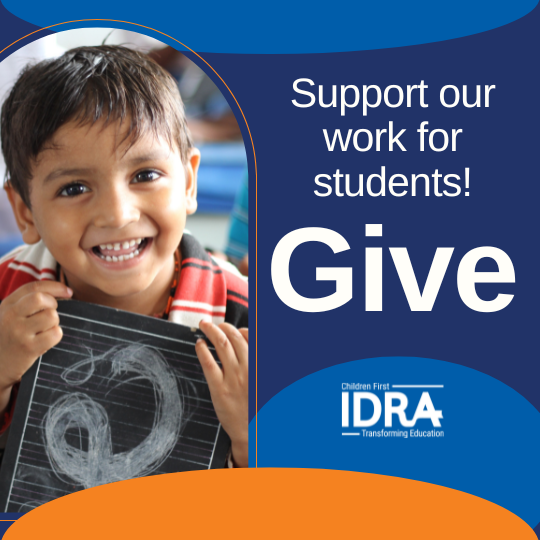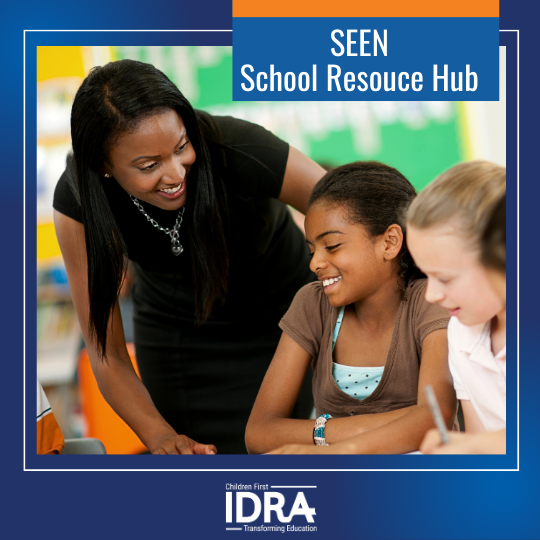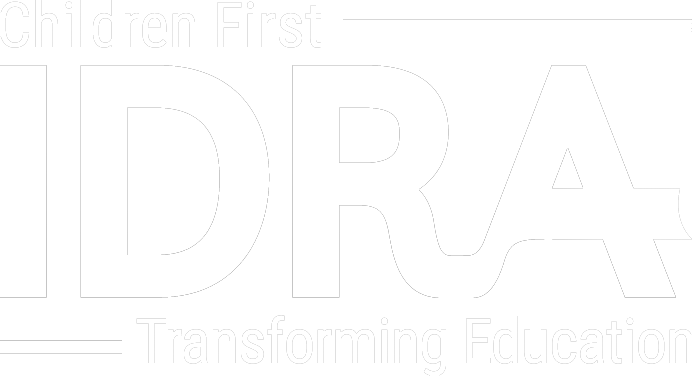• By Christie L. Goodman, APR, Fellow PRSA • IDRA Newsletter • May 2025 • 
Successful students naturally get accolades. They receive awards and privileges. They get to lead clubs, like honor societies and student councils. This is appropriate. They worked hard for it. And the school community shows that it values them and their success.
And then there are the students who struggle. It shows up in their grades. It shows up in their repeated absences. It shows up in their disciplinary referrals. These are the students whose parents cringe when the school’s phone number shows up on their caller ID. It’s always bad news.
 Until one day, a teacher, a counselor or a principal says to the student, “I see you.” Something magical happens when these youth hear: “I see leadership in you. I know of some elementary students who need your help.”
Until one day, a teacher, a counselor or a principal says to the student, “I see you.” Something magical happens when these youth hear: “I see leadership in you. I know of some elementary students who need your help.”
That magic happens when these students are introduced to the IDRA Valued Youth Partnership (VYP). The school demonstrates that it values them too.
“I thought that I wasn’t good because I had many problems,” a tutor shared. “I thought I was a nobody. But when I started talking to my tutees and working with them, I felt different. Now I know that I can be somebody, and I can help others to do the same.”
Turning an Idea into Something Powerful
For four decades, VYP has helped schools and communities see what is on the inside – the inherent value and potential of each child.
The seeds of the program drew from the cross-age tutoring experiences of many future IDRA leaders prior to IDRA’s founding. Also at the time, peer and cross-age tutoring was being used to help alleviate the U.S. teacher shortage.
VYP took shape first as a dropout prevention and youth leadership program. The notion of uplifting youth who were in at-risk situations came from IDRA’s belief in helping students most harmed by inequities and injustices in school systems.
In 1984, Coca-Cola USA approached then-San Antonio Mayor Henry Cisneros about starting a dropout prevention initiative for Latino youth as their national dropout rate was as high as 80%. (Danini Supik, 1994)
IDRA was in the midst of its landmark study on attrition rates in Texas. It was the first study of dropouts in the state. Schools were losing one in three students from high school, and three out of 10 Texas dropouts had completed fewer than nine years of schooling when they left. About half of all Latino students in Texas dropped out before entering the ninth grade. Schools were losing more than half of their Black students as well.
Cisneros contacted IDRA founder and director José Cárdenas, Ed.D., and IDRA was subsequently awarded a four-year grant to create a new model to operate in four San Antonio school districts.
“When I first started VYP, I didn’t think that I could ever have a meaning in a person’s life. But being in the VYP has shown me that my presence matters.”
– Carly Oliver, VYP tutor
The IDRA Valued Youth Partnership was born. Built on the philosophy that “all children are valuable; none is expendable,” this in-school program works by identifying youth who are in at-risk situations and enlisting them as tutors for elementary school youngsters who are also struggling in school.
Given this role of personal and academic responsibility, the Valued Youth tutors learn self-discipline and develop self-esteem. Schools see the philosophy and practices of valuing students considered at-risk in action.
 “VYP gives an opportunity for young people to see themselves and for others to see them as the valuable and important young people that they are not limited by adult or school perceptions about them,” described IDRA President Emerita Dr. María “Cuca” Robledo Montecel.
“VYP gives an opportunity for young people to see themselves and for others to see them as the valuable and important young people that they are not limited by adult or school perceptions about them,” described IDRA President Emerita Dr. María “Cuca” Robledo Montecel.
Four days a week, Valued Youth tutors go to the nearby elementary school, where they work with up to three tutees. They develop a bond with their young charges and celebrate their tutees’ shared successes.
A middle school tutor said, “This past month, the best thing about tutoring was that [the tutees] told me they love me!!!!!!!”
Another shared how the program helped her too, “I have learned to ‘practice what I preach.’ So, if I expect my kids to have their homework done on time, I had better have it done also.”
On the fifth day of each week, the tutors meet together to learn tutoring strategies, have guest speakers from their communities, and engage in college prep activities. The college component is significant among these students who could no longer see college in their future and may have already been directed away from college expectations by educators.
Over the years, IDRA has maintained the same rigorous, comprehensive evaluation of VYP. The findings have remained consistent: a dropout rate of less than 2%, higher attendance, lower discipline rates, stronger academic skills, and higher self-esteem for the tutors.
In 1994, tutor Anna Rosario described her experience: “I didn’t like to go to school. A few times, I even participated in ‘skipping parties.’ I almost got involved in a gang because I am at that age when you don’t care what anybody says. My friends drank, and they would always say, ‘Get in, get in.’ I disrespected my teachers and even my mom. I had terrible grades. I made Fs in school. Today, now that I’ve been in the program, I want to come to school. I participate in sports. I try to do all my work. I respect my teachers. I am more mature about my work and other responsibilities. Now I make Bs and Cs. I get along with my mom now. It is a better picture of my life.”
The program design is backed by research on socio-emotional factors and learning. The results have shown that 61% of tutors had an improved sense of self, 59% felt more involved and caring toward their families, 54% felt more productive and successful at school, 66% had improved reading test scores, and 57% had improved math scores. (IDRA, 2016-2020)
Read what students have to say about the IDRA Valued Youth Partnership Program. Also see reflections by students in IDRA’s VisionCoders and Youth Leadership Now programs.
The program is personally transformative for students, as explained by 2023 tutor Carly Oliver: “When I first started VYP, I didn’t think that I could ever have a meaning in a person’s life. But being in the VYP has shown me that my presence matters, and I do have meaning in a student’s life, one way or another. This class has shown me how much meaning I can have in the world, and it makes me extremely proud.”
Support over the years has come from federal, corporate, state, local and school district funding. VYP has also gained accolades over its four decades, earning recognition as an exemplary program by the U.S. Department of Education, being named one of only 30 programs worldwide selected for inclusion in the International Youth Foundation database, and being designated a Hispanic Ed “Bright Spot” by the White House.
Since its inception in 1984-85, VYP has positively impacted the lives of over three-quarters of a million children, families and educators in states across the continental United States in Puerto Rico and even in England and Brazil.
Today’s Need for Re-engaging Students
Innovative dropout prevention and youth leadership programs are just as necessary today as they were 40 years ago, as school attrition rates negatively impact communities across the nation. The national dropout rate in 2022 for 16- to 24-year-olds was 5%, with rates and data collection methods varying by state (NCES, 2024). For example, the graduation rate in Georgia for 2024 was a reported 85%, which means that 15% of students did not graduate. (GDE, 2024)
Based on data from IDRA’s Texas public school attrition study, Texas schools are failing to graduate one out of every five high school students, as 22% of the freshman class of 2019-20 left prior to graduation. Notably, 2022-23 was the first school year in nearly three decades to reverse steady decline in student attrition in Texas. These data also underscore the significant and unprecedented role of the COVID-19 pandemic on chronic absenteeism. (Quintanilla-Muñoz & Sánchez, 2022)
Coming out of the pandemic, data across the country showed that students disengaged at alarmingly high rates. Daily student absence rates nearly doubled from an average of 6% prior to the pandemic to 10% (Kurtz, 2020). Teen disengagement was on the rise (Bauer, et al., 2020).
Naturally, when students feel they are overwhelmingly behind and in a constant state of needing to catch up, they can lose hope in school and in themselves. When schools try to rush a solution with highly sequential and prescriptive “drill” pedagogies, they find it highly detrimental to students experiencing disengagement (Bojorquez, 2022).
In contrast, as VYP demonstrates, reversing these trends requires intentional strategies, like creating purposeful experiences in classrooms, recognizing student strengths and contributions, and maintaining positive relationships between teachers and students.
“A lot is happening right now in the world around us – where some young people and their families are made to feel unwelcome for being who they are, labeled as problems to fix, or made to feel that they aren’t meant for college,” said IDRA President & CEO Celina Moreno, J.D., to current tutors recently at a VYP anniversary celebration.
“But we will never give up on our vision of preparing all students for college so that all students can have options that will help them determine their own futures and thrive in college and beyond.”
Expanding Legacy of Valuing Youth
VYP’s astounding success demonstrates what happens when schools use asset-based practices. Never one to stop innovating, IDRA has taken the bedrock qualities of youth leadership and applied them to other programs.
For example, 15 years ago, IDRA’s Youth Tekies program served high school students who others had written off as not “college material.” IDRA gave them leadership roles to help their peers access college information through community technology centers.
Similarly, today’s IDRA Digital Ambassadors program is enriching underserved communities, like those in the Rio Grande Valley, by supporting students as leaders and technology trainers for their local communities.
In addition, three large in-school programs are impacting hundreds of students.
- The IDRA Youth Leadership Now program integrates VYP for high-need eighth grade students while expanding impact schoolwide by also integrating teacher mentoring to prepare students for high school with our family leadership model, IDRA Education CAFÉ.
- IDRA VisionCoders is an eighth grade computer science course in Title I middle schools where students create educational games for early elementary “buddies.”
- IDRA Youth TechXperts will launch in August with middle school students building cutting-edge STEM skills to provide campus technology support while fostering leadership, inclusivity and real-world experience.
The success of VYP and its active asset philosophy does not happen in a vacuum. This is a shared success story. VYP is made possible by so many people with that shared vision, people like our school leaders and our fabulous teacher coordinators, who work with our tutors every day. We honor the students’ families and communities. We are grateful to school districts, foundations, businesses and governmental agencies whose support makes this program possible.
And most especially, we celebrate the students themselves, who made an immeasurable difference in the lives of their tutees and who went on to earn college degrees, to become teachers, to become civic and business leaders, and to live out their dreams from valued youth to valuing adults. Just like magic.
Resources
Bauer, L., Lu, S., & Moss, E. (October 1, 2020). Teen Disengagement is on the Rise. Brookings.
Bojorquez, H. (2022). Ready – Renew – Reconnect! Proven Strategies for Re-engaging Students Who Need You the Most. IDRA.
Bojorquez, H. (March 2010). Supporting the Dream of Going to College Through Powerful Student Engagement. IDRA Newsletter.
Danini Supik, J. (October 1994). The Coca-Cola Valued Youth Program: An Idea That Works. IDRA Newsletter.
GDE. (October 2024). Georgia Students Record Another Historic-High Graduation Rate. Georgia Department of Education.
IDRA. (2016-2020). Program evaluations and data analysis, unpublished.
Kurtz, H. (October 15, 2020). In-Person Learning Expands, Student Absences Up, Teachers Work Longer, Survey Shows. Education Week.
NCES. (2024). Status Dropout Rates. Condition of Education. National Center for Education Statistics.
Quintanilla-Muñoz, C., & Sánchez, J. (June 2022). Pandemic-Legacy High School Attrition Rate Increases Two Points; Black-White Gap Widens to 15 Points. IDRA Texas Public School Attrition Study, 2022-23.
Robledo Montecel, M. (2009). Continuities: Lessons for the Future of Education from the IDRA Coca-Cola Valued Youth Program. IDRA.
Robledo Montecel, M. (October 2003). IDRA Coca-Cola Valued Youth Program – Model Dropout Prevention Program. IDRA Newsletter.
Robledo, María R., Cárdenas, José A., Supik, Josie D., et al. (1986). The Texas School Dropout Survey Project: A Summary of Findings. IDRA.
Vasquez, B. (December 2018). Three Decades of Groundbreaking Dropout Research – Reflections by Dr. Robledo Montecel. Texas Public School Attrition Study, 2017-18.
Christie L. Goodman, APR, Fellow PRSA, is IDRA’s director of communications. Comments and questions may be directed to her via email at christie.goodman@idra.org.
Thanks to Sarah Bishop, M.A., for her assistance with this article.
[© 2025, IDRA. This article originally appeared in the May edition of the IDRA Newsletter. Permission to reproduce this article is granted provided the article is reprinted in its entirety and proper credit is given to IDRA and the author.]



